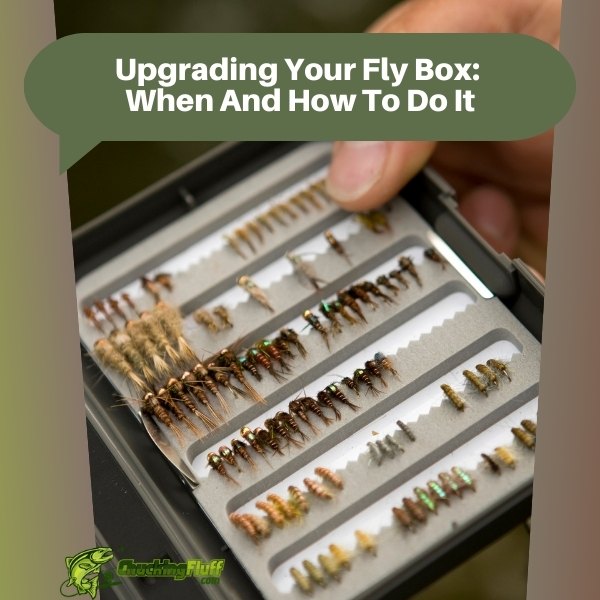| Disclosure: Just to be open and honest the buttons and links you click on in the website will in most cases take you to another website where you can purchase the products I am reviewing. As an Amazon Associate I earn from qualifying purchases. |
Upgrading Your Fly Box: When And How To Do It
Quick Post Navigation
Introduction
Upgrading your fly box is like upgrading your entire fishing experience. Imagine the frustration of reaching into your box, only to find flies that don’t fit the moment or worn-out ones that don’t attract fish. Many anglers hesitate when it comes to upgrading their gear, thinking it’s unnecessary or costly. But sometimes, it’s not only beneficial—it’s essential for your success on the water. So, when should you make the leap, and how should you go about it? This guide explores the signs that it’s time to upgrade, offers advice on organizing your new setup, and provides tips to ensure your fly box meets your every need.
Why Upgrade Your Fly Box?
The Evolution of Your Fly Fishing Needs
As with any hobby, your skills and interests in fly fishing grow over time. What worked when you were just starting out may no longer cut it now. Maybe you’ve transitioned from trout fishing in local streams to pursuing saltwater species. With new techniques and preferences, you’ll need a fly box that reflects your current style. The setup that used to work may simply be out of sync with where you are today.
Adapting to Changing Seasons and Locations
Each season brings different conditions, influencing which flies work best. Early spring may call for one set of patterns, while mid-summer and autumn demand another. Moving from a river setting to a lake or coastal waters changes the game, too. A well-updated fly box allows you to adapt to these changes seamlessly, keeping you prepared and preventing those frantic last-minute fly swaps.
Keeping Up with New Techniques and Trends
Every year, new fly patterns and fishing techniques emerge. These innovations often respond to what fish are eating, making them crucial if you want to stay on top of your game. Keeping an eye on new patterns and regularly refreshing your fly box with these trends not only makes you a better angler but keeps the experience fresh and exciting.
Signs It’s Time to Upgrade Your Fly Box
You’re Running Out of Space
If you find yourself cramming flies into every available nook and cranny, it’s likely time for an upgrade. Running out of space limits your flexibility and makes it harder to access what you need, leading to frustration on the water.
Flies Are Worn Out or Damaged
Flies don’t last forever. Hooks dull, feathers fall off, and wear is inevitable. A fly box full of battered flies can ruin a day out. An upgrade lets you replace these old flies with ones in prime condition, ready to catch the attention of even the pickiest fish.
Constantly Losing or Misplacing Flies
Do you frequently find yourself rummaging through your box, searching for that one specific fly? A cluttered fly box not only wastes time but also makes it more likely that you’ll lose or misplace flies. A structured upgrade with better organization can save you time and preserve your sanity.
Your Skills and Preferences Have Evolved
As you gain more experience, you may shift focus on specific types of flies or techniques. If you’ve found new confidence in using wet flies or have started targeting larger species, your fly box should reflect these changes with a fresh selection of flies to match your expertise.
Essential Considerations for Upgrading
Determining Your Fly Fishing Style
Are you primarily a river angler, a lake fisher, or do you target saltwater species? Understanding your fishing environment and style is crucial when upgrading your fly box. Each setting requires a unique assortment of flies, so having the right variety is essential.
Deciding on Box Size and Compartments
A larger fly box with multiple compartments might be ideal for someone who likes to keep every type of fly at their fingertips, while a compact box could suit those who prefer a minimalistic approach. Consider how often you plan to upgrade—choosing the right box size from the start can save money and hassle later on.
Material and Durability Factors
Fishing often exposes gear to moisture, dirt, and heavy handling. Consider boxes made of waterproof, durable materials that can withstand the outdoor elements. Sturdy materials protect both the flies and the box, offering a better return on investment.
Selecting the Right Flies for Your Upgraded Box
Types of Flies Based on Targeted Fish
Different fish species are attracted to different flies, and having the right variety tailored to your target species can make all the difference. Consider the types of fish you typically pursue and stock your box with patterns known to attract them.
Adjusting Fly Selection by Season
Seasonal shifts mean changes in fish feeding habits. For instance, summer may require larger flies to mimic plentiful insects, while colder months call for smaller, more precise patterns. A seasonal rotation in your fly box ensures you’re ready no matter when you head out.
Incorporating New Fly Patterns
If you’re constantly reaching for a specific fly, consider incorporating new patterns that work similarly but offer a fresh approach. This keeps your fishing experience dynamic and challenges you to experiment with different options, which can be rewarding both in technique and catch.
Arranging and Organizing Your New Fly Box
Choosing an Organization System
Are you someone who likes to organize by type, color, or size? Deciding on an organization system before you start filling up your new box can help you stay consistent and find flies more easily when you need them.
Arranging by Type, Size, or Season
Organizing by fly type (e.g., nymphs, dry flies, streamers) is often practical for anglers who target specific fish based on their behavior. Others may prefer grouping flies by season or size for quick access, depending on conditions. Choose what works best for your personal fishing habits.
Using Fly Box Dividers and Labels
Dividers and labels can make a world of difference when it comes to finding the right fly quickly. Using labeled sections or color-coded dividers helps you organize flies more precisely, so you’re never scrambling to find the one you need.
Tips for Maintaining Your Fly Box
Regularly Inspecting for Wear and Tear
A quick inspection before and after each trip can help you identify damaged or worn-out flies. This routine maintenance will extend the life of your flies and ensure you’re always fishing with effective gear.
Cleaning and Drying Your Box
Over time, moisture and debris accumulate in your box. Regularly empty and clean your fly box to prevent mold or corrosion. Dry it thoroughly before reassembling to keep your flies in top condition.
Avoiding Moisture Buildup
If your box is constantly exposed to water, consider storing a small desiccant pack inside to prevent moisture buildup. This simple trick helps protect both the flies and the materials, preserving your investment.
When to Consider Multiple Fly Boxes
Organizing by Season or Fish Species
Some anglers find it helpful to have separate boxes dedicated to different seasons or types of fish. This ensures that no matter when you fish, you’ll have a box with the exact flies you need, preventing overpacking or underpreparing.
Creating Separate Boxes for Different Locations
If you frequently travel to fish in different areas, having a box dedicated to each location can simplify packing. A specialized box tailored to a particular lake, river, or coastline lets you adapt without overwhelming your setup.
Conclusion
Upgrading your fly box is a worthwhile endeavor that can elevate your fishing experience. By carefully considering your current needs, choosing the right flies, and maintaining an organized box, you’ll be ready for any fishing adventure. An upgrade isn’t just about getting more flies or a fancier box; it’s about aligning your gear with your skills, ambitions, and love for the sport.
FAQs
1. How often should I upgrade my fly box?
Generally, a fly box should be upgraded when you outgrow it or when it no longer serves your fishing style effectively. Every few years or whenever you change focus or develop new skills, it may be time to revisit your setup.
2. What’s the best way to organize a fly box?
The organization depends on personal preference. Many anglers sort by fly type, season, or target species. Dividers and labels also help streamline access.
3. Can I use one fly box for all types of fishing?
While you can use one fly box, many anglers find multiple boxes beneficial, especially if they fish in different environments or seasons. This way, you’re always prepared with the right flies.
4. How do I know if my flies are too worn out?
If hooks are dull, feathers or fibers are damaged, or the fly loses its original shape, it’s likely too worn to be effective. Replacing these flies ensures you’re not fishing with subpar gear.
5. Are expensive fly boxes worth it?
Higher-quality boxes often last longer and protect flies better, so while they may cost more initially, they can be a worthwhile investment, especially for avid anglers.



